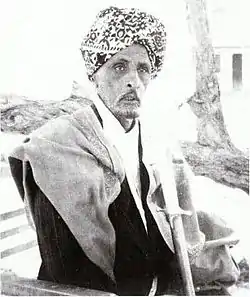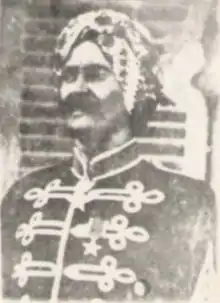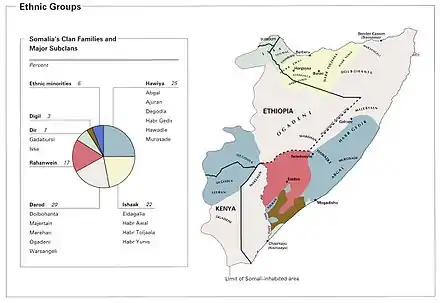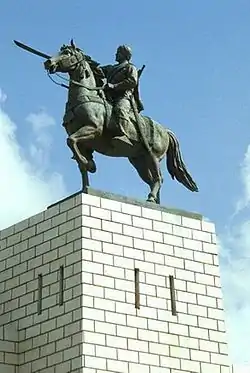Darod
The Darod (Somali: Daarood, Arabic: دارود) is a Somali clan. The forefather of this clan was Sheikh Abdirahman bin Isma'il al-Jabarti, more commonly known as Darood.[1][2][3] In Somalia members of the clan settle in the Federal Member States of Jubbaland and Puntland. Furthermore, the clan has an ancillary presence in pockets of the states of Koonfur-Galbeed and Galmudug. In Somaliland the clan settle the eastern regions of Sool, Sanaag and Cayn. In Ethiopia the clan settles in the Somali State region, whilst in Kenya they settle in the North Eastern Province.[4]
دارود | |
|---|---|
 | |
| Regions with significant populations | |
| Languages | |
| Somali | |
| Religion | |
| Islam (Sunni) | |
| Related ethnic groups | |
| Dir, Hawiye, Isaaq, Rahanweyn, other Somalis |
The Darod clan is one of the largest Somali clans in the Horn of Africa.[5][6][7]
Origins

According to early Islamic books and Somali tradition, Aqeel Abu Talib ibn Abd al-Muttalib Al-Qurashi descendant Abdirahman bin Isma'il al-Jabarti (Darod), a son of the Sufi Sheikh Isma'il al-Jabarti of the Qadiriyyah order, fled his homeland in the Arabian Peninsula after an argument with his uncle.[8][9] During the 10th or 11th century CE,[10] Abdirahman is believed to have then settled in northern Somalia just across the Red Sea and married Dobira, the daughter of the Dir clan chief. This union is said to have given rise to the Darod clan family.[11] Thus, it established matrilateral ties with the Samaale main stem.[12]
According to the British anthropologist and Somali Studies veteran Ioan Lewis, the traditions of descent from noble Arab families related to the Prophet are most probably figurative expressions of the importance of Islam in Somali society.[13][14] However, "there is a strong historically valid component in these legends which, in the case of the Darod, is confirmed in the current practice of a Dir representative officiating at the ceremony of installation of the chief of the Darod family."
A similar clan mythology exists for the Isaaq, who are said to have descended from one Sheikh Ishaq ibn Ahmad al-'Alawi, another Banu Hashim who came to Somalia around the same time.[8][10] As with Sheikh Isaaq, there are also numerous existing hagiologies in Arabic which describe Sheikh Darod's travels, works and overall life in northern Somalia, as well as his movements in Arabia before his arrival.[15] Besides historical sources such as Al-Masudi's Aqeeliyoon,[9] a modern manaaqib (a collection of glorious deeds) printed in Cairo in 1945 by Sheikh Ahmad bin Hussen bin Mahammad titled Manaaqib as-Sheikh Ismaa'iil bin Ibraahiim al-Jabarti also discusses Sheikh Darod and his proposed father Isma'il al-Jabarti, the latter of whom is reportedly buried in Bab Siham in the Zabid District of western Yemen.[16]
Sheikh Darod's own tomb is in Haylaan, situated in the Hadaaftimo Mountains in northern Somalia, and is the scene of frequent pilgrimages.[17] Sheikh Isaaq is buried nearby in Maydh,[18] as is Sheikh Harti, a descendant of Sheikh Darod and the progenitor of the Harti Darod sub-clan, whose tomb lies in the ancient town of Qa’ableh.
Sheikh Darod's mawlid (birthday) is also celebrated every Friday with a public reading of his manaaqib.[16]
The Darod were supporters of Imam Ahmad ibn Ibrahim al-Ghazi during his 16th century conquest of Abyssinia; especially the Harti, Marehan and Bartire sub-clans, who fought at Shimbra Kure, among other battles.[19] In his medieval Futuh Al-Habash documenting this campaign, the chronicler Shihāb al-Dīn indicates that 300 Harti soldiers took part in Imam Ahmad's Adal Sultanate army. He describes them as "famous among the infantry as stolid swordsmen" and "a people not given to yielding".[20]
Lineage

Darod is believed to be the son of the famous Arabian Sheikh, Ismail bin Ibrahim Al-Jabarti, who is buried in the Zabid District of Yemen who is believed to have descendant of Aqeel ibn Abi Talib who in turn hails from the Quraysh, a historically significant Arab tribe that the final prophet of Islam, Muhammed hails from.[21] In 2009, former President of Somalia, Abdullahi Yusuf visited the grave of Ismail bin Ibrahim Al-Jabarti in Yemen[22]
According to many medieval and modern Islamic historians, Darod is descended from Aqeel ibn Abi Talib, the cousin of Muhammad and brother of Ali ibn Abi Talib. An ancient Islamic history book, called Aqeeliyoon by Al-Masudi, talks in detail about the descendants of Aqeel ibn Abi Talib, wherein Darod is also mentioned.[9] The book gives Sheikh Darod's lineage as Abdirahmaan Bin Ismaa'iil Bin Ibraahim Bin Abdirahmaan Bin Muhammed Bin Abdi Samad Bin Hanbal Bin Mahdi Bin Ahmed Bin Abdalle Bin Muhammed Bin Aqail Bin Abu-Talib Bin Abdul-Mutalib Bin Hashim Bin Qusaya.
According to Allaa'i Alsuniyah Fi Al-Aqab Al-Aqeeliyah (2006) by Ahmed bin Ali Al-Rajihi Al-Aqeeli, the lineage of Sheikh Darod/Da'ud is: "Da'ud ibn Ismail ibn Ibrahim ibn Abdulsamad ibn Ahmed ibn Abdallah ibn Ahmed Ibn Ismail ibn Ibrahim ibn Abdallah ibn Isma'il ibn Ali ibn Abdallah ibn Muhammad ibn Hamid ibn Abdallah ibn Ibrahim ibn Ali ibn Ahmed ibn Abdallah ibn Muslim ibn Abdallah ibn Muhammad ibn Aqeel ibn Abi-Talib Al-Hashimi Al-Qurashi". Al-Aqeeli adds that Sheikh Isma'il's sons include Abi-Bakar, Da'ud, Ahmad and Abdulsamad, whose other offspring inhabit the Hadhramaut and Mahra regions in Southern Arabia.[23]
Distribution

The Darood are believed to be a large Somali clan both in terms of population size and land inhabitation. The Darood constitute a big presence in the Somali Region of Ethiopia[25] and are also the largest Somali clan in North Eastern Province of Kenya.[26] Within Somalia, the Darood are also one of the largest clans, with traditional strongholds in the north, modern day Puntland state which is dominated by the Harti subclan of Darood. In addition, the Marehan, Ogaden, Jidwaaq, and Harti Darod members are also settled further down south in the Gedo region as well as the Middle Jubba and Lower Jubba regions of Somalia. The Darood in Somalia, roughly corresponds to the Darood's settled within the Jubbaland and Puntland states.
Major Darood Settlements within Somalia include Galkacyo, Kismaayo, Bosaso, Las Anod, Buuhoodle and Garowe.
Darood are also the largest clan in Jigjiga in Ethiopia, and Garissa in Northern Kenya.
Nobility
The Darod clan has produced numerous noble Somali men and women over the centuries, including many Sultans. Traditionally, the Darod population was mostly concentrated in the northern and northeastern cities on the Gulf of Aden and upper Indian Ocean coast in the Horn of Africa. Darod noble men ruled these settlement pockets until the European colonial powers changed the political dynamics of Somalia during the late 19th century. Before many Darods began pushing southward in the mid-1850s, the Majeerteen Sultanate and Sultanate of Hobyo held steadfast in solidly established posts from Alula to Hobyo.
Clan tree

There is no clear agreement on the clan and sub-clan structures and many lineages are omitted. The following listing is based upon the World Bank's Conflict in Somalia: Drivers and Dynamics from 2005 and the United Kingdom's Home Office publication, Somalia Assessment 2001.[28][29]
- Darod (Daarood)
- Geri Kombe[30]
- Harla[31][32]
- Sade
- (Marehan)
- Reer Dini
- Reer Hassan
- Eli Dheere
- (Marehan)
- Tenade
- Leelkaase
- Kabalah
- Absame
- Harti
- Dishiishe (Dishishe)
- Warsangali (Warsengeli)
- Majeerteen (Mijerteen)
- Wabeeneeye
- Reer Biciidyahaan
- Siwaaqroon
- Ali Saleeban [33]
- ugaar saleeban
- Mahamoud Saleeban
- Omar Mahmud
- Issa Mahmud
- Osman Mahmoud
- Dhulbahante (Dolbahante)
- Mohamud Garaad
- Jama Siad
- Ugadhyahan
- Farah Garaad
- Baharsame
- Barkad
- Ahmed Garaad
- Abdi Garaad
- Khayr Abdi
- Omar Abdi
- Mohamud Garaad
In the south central part of Somalia the World Bank shows the following clan tree:[34]
One tradition maintains that Darod had one daughter .[35]
Darod's tomb
Darod is buried in an old town called Haylaan near Badhan in the north-eastern Sanaag region of Somalia. His wife Dobira is buried just outside the town. The surrounding buildings and the mosque near the tomb was built by the former president of Somalia Abdullahi Yusuf.
Darod is believed to be the son of the famous Arabian Sheikh, Ismail bin Ibrahim Al-Jabarti, who is buried in the Zabid District of Yemen. Tradition holds that he is descended from the Banu Hashim.
In 2009, former President of Somalia, Abdullahi Yusuf visited the grave of Ismail bin Ibrahim Al-Jabarti in Yemen[22]
Sheikh Darod's mawlid (birthday) is celebrated every Friday with a public reading of his manaqib and passages in the Quran.
Sons of Sheikh Darod Ismail
- Ahmed bin Abdirahman: Sade Darood
- Muhammad bin Abdirahman: Kablalax Darood
- Hussien bin Abdirahman: Tanade Darod
- Yousuf bin Abdirahman: Awrtable Darood
- Eissa bin Abdirahman: Cisse Darood
Notable Darod people
Rulers
- Garaad Wiil-Waal Liberated Jigjiga from the Oromo invaders in the 1700s
- Mohammed Abdullah Hassan, Ogaden, the Sayyid; religious and nationalist leader of the Dervish State; called the Mad Mullah by the British
- Nur ibn Mujahid, Marehan, second Conqueror of Ethiopia and the Patron Saint of Harar was one of rulers of parts of the Horn of Africa.
- Ali Yusuf Kenadid, Majerteen, Last Sultan of the Sultanate of Hobyo
- Mohamoud Ali Shire, Warsangeli, Sultan of former "British Somaliland" (1897–1960)
- Siad Barre, Marehan, third President of Somalia, 1969–1991, Leader of the most successful part of Somalia's history
- Ugas Yasin Ugas Abdurahman former ruler of Bosaso
Inventors and founders
- Osman Yusuf Kenadid, Majerteen, Inventor of the Osmanya Script.
- Shire Jama Ahmed, Marehan, inventor of the Somali script
- Haji Bashir Ismail Yusuf, Majeerteen, first President of Somali National Assembly; former Minister of Health and Labor of Somalia (1966–67)
Lawyers and legislators
- Ahmed Sheikh Ali Ahmed, Marehan former President of Court of Appeal, Somali Democratic Republic.
- Ahmed Hussen, Majeerteen, Minister of Immigration of Canada
- Abdulqawi Yusuf, Majerteen, prominent Somali international lawyer and president on the International Court of Justice.
- Ilhan Omar, Majerteen, Member of the Minnesota House of Representatives
- Mohamud Ali Magan, Marehan, Somali Foreign Affairs, Consul General to Unites States Of America and Canada
- Amina Mohamed, Dhulbahante, former Chairman of the International Organization for Migration and the World Trade Organisation's General Council
- Yusuf Mohamed Ismail, Majeerteen, former Ambassador of Somalia to the United Nations Human Rights Office in Geneva
Writers and musicians
- Abdulkadir Hersi Siyad Yamyam, Marehan, was a Somali poet and playwright.
- Ahmed Farah Ali Idaaja, Marehan, one of the first Somali language writers and "father" of the Somali written folklore
- Nuruddin Farah, Ogaden, World-famous Somali novelist
- Ahmed Rasta, Marehan, singer. Knicknamed Boqorka Codka (King of Voice.)
- Aar Maanta, Ogaden, Somali-British singer-songwriter, actor, composer, instrumentalist and music producer.
- Mohamed Nuur Giriig, Warsangeli, Classical Singer. (1935 - 2002)
- Saado Ali Warsame, Dhulbahante, singer-songwriter and former MP in the Federal Parliament of Somalia
- Faarax Maxamed Jaamac Cawl, Warsangeli, writer
Military leaders and personnel
- Abdulkadir Sheikh Dini, Marehan, Former minister of defence of Somalia
- Abdullahi Anod, Marehan, Former Head Commander of Somali Military Forces
- Mohammed Said Hersi Morgan, Majeerteen, Defense Minister Under The Siad Barre Government
- Yusuf Osman Dhumal, Marehan, Former Head Commander of Somali Military Forces
- Abdirizak Haji Hussein, Majeerteen, former Prime Minister of Somalia, and former Secretary General of the Somali Youth League.
- Barre Adan Shire Hiiraale, Marehan, Former minister of defence of Somalia, Head Jubba Valley Alliance
- Jama Ali Korshel, Warsangeli, Somali Army General, former Head of Somali Police and one of the leaders of 1969 coup d'état of Somalia
- Ahmed Warsame, Marehan, Head of the Somali Military Academy.
- Abdullahi Ahmed Jama, Warsangeli, Former Minister of Justice and 1977 Ogaden War Veteran
- Mohamed Abshir Muse, Majerteen, First Commander of the Somali Police Force
- Bashir Abdi Mohammed "Ameeriko", Majerteen, current Somali federal government police force commander [36][37]
Politicians
- Mohamed Abdullahi Mohamed (Farmajo), Marehan, Current President of Somalia
- Abdullahi Yusuf Ahmed, Majeerteen, former President of Somalia, First President and founding father of Puntland
- Abdi Farah Shirdon, Marehan, former Prime Minister of Somalia
- Hirsi Bulhan Farah Majeerteen, former Minister in the civilian government of the 1960s, political prisoner and Pan-Somalist.
- Aden Ibrahim Aw Hirsi, Marehan, Author, Politician - Former minister of planning of Jubaland state of Somalia.
- Abdirashid Ali Shermarke, Majeerteen, second President of Somalia, 1967–1969
- Mohamed Aden Sheikh, Marean premier Somali intellectual and former head of Somali Technological Development, Minister of Information, Minister of Education, Head of the Ideology Bureau SRRC
- Omar Haji Massale, Marehan, Former minister of defence of Somalia
- Abdiweli Mohamed Ali, Majeerteen Current President of Puntland
- Abdi Shire Warsame, Marehan, former Somali Ambassador to Kenya and China and Former Foreign Affairs State minister in Transitional National Government
- Ahmed Mohamed Islam(Axmed Madoobe), Ogaden, President of Jubbaland State of Somalia
- Abdiwahid Gonjeh, Marehan, Formar Prime minister of Somalia, member of upper house
- Ahmed Elmi Osman (Karaash), Dhulbahante, Minister of Interior of Puntland and former President of Khatumo State
- Fatimo Isaak Bihi, Marehan, first Somali female ambassador, Ambassador to Geneva, Director of the African Department of the Ministry of Foreign Affairs
- Abdi Mohamoud Omar, Ogaden, President of Somali region of Ethiopia
- Abdulahi Sheik Ismael Fara-Tag, Member of sen of upper house
- Abdihakim Abdullahi Haji Omar, Dhulbahante, Vice President of Puntland
- Ahmed Mohamed Hassan, Marehan, Member of the Pan-African Parliament from Djibouti
- Abdirahman Mohamud Farole, Majeerteen, Former President of Puntland
- Abdirizak Haji Hussein, Majeerteen, former Prime Minister of Somalia, and former Secretary General of the Somali Youth League.
- Abdirizak Jurile Dishiishe, Veteran politician, Diplomat & Professor. Former TFG minister of planning & International Cooperation, Former MP, former Executive director of numerous UN and International organisations, Senator
- Abdiweli Sheikh Ahmed, Marehan, Former Prime Minister of Somalia
- Omar Abdirashid Ali Sharmarke, Majeerteen, Prime Minister of Somalia, and son of Abdirashid Ali Shermarke
- Abdulkadir Abdi Hashi, Leelkase, State Minister of the Presidency for Planning and International Relations of Puntland
- Farah Ali Jama, Majeerteen, former Minister of Finance of Puntland
- Abdulahi Bille Nour, Dishiishe, Somali State Minister of Education, Cultural & Higher Education, One of Somali longest serving national MPs.
- Abdulrahman Jama Barre, Marehan, former Foreign Minister of Somalia and close relative of Siad Barre
- Shukran Hussein Gure, Ogaden, MP for Garissa County
- Said Mohamed Rage, Dishiishe, Founder of Puntland Counter-piracy Agency and Puntland Minister of Ports, Marine Transportation and Marine Resource
- Farah Maalim, Ogaden, Deputy Speaker in the Parliament of Kenya
Pilots
- Asli Hassan Abade, Ogaden, First Ever African Female Military Pilot
- Ali Matan Hashi, Marehan, first Somali pilot, commander of Somali Airforce 1959–1978, Minister of Justice, Minister of Health, Somali Nationalist.
Athletes
- Abdi Bile, Dhulbahante, former middle-distance runner and 1500m world champion in 1987.
Other
- Iman (model), Majeerteen, a supermodel, actress and entrepreneur
- Fatima Jibrell, Dhulbahante, Somali-American environmentalist
- Haji Mohamed Yasin Ismail, Majeerteen, entrepreneur and presidential candidate
- Hirsi Magan Isse, Majeerteen, scholar and one of the leaders of the Somalian revolution
- Nathif Jama Adam, Ogaden, Governor of Garissa County and former Head of the Sharjah Islamic Bank's Investments & International Banking Division
Notes
- "Somalia: Minorities and indigenous peoples". Minority Rights Group International. Retrieved 18 September 2019.
- Lewis, Ioan M (1999). A Pastoral Democracy: A Study of Pastoralism and Politics Among the Northern Somali of the Horn of Africa. James Currey Publishers. p. 12. ISBN 9780852552803. Retrieved 18 September 2019.
- Lewis, Ioan M (July 1959). "Clanship and Contract in Northern Somaliland". Africa: Journal of the International African Institute. 29 (3): 274. doi:10.2307/1157617. JSTOR 1157617. Retrieved 18 September 2019.
- Ethnic Groups (Map). Somalia Summary Map. Central Intelligence Agency. 2002. Retrieved 2012-07-30. Perry–Castañeda Library Map Collection - N.B. Various authorities indicate that the Darod is one of the largest Somali clans , whereas others suggest that the Hawiye is the largest Somali clan within Somalia .
- "Somalia: Minorities and indigenous peoples". Minority Rights Group International. Retrieved 18 September 2019.
- Lewis, Ioan M (1999). A Pastoral Democracy: A Study of Pastoralism and Politics Among the Northern Somali of the Horn of Africa. James Currey Publishers. p. 12. ISBN 9780852552803. Retrieved 18 September 2019.
- Lewis, Ioan M (July 1959). "Clanship and Contract in Northern Somaliland". Africa: Journal of the International African Institute. 29 (3): 274. doi:10.2307/1157617. JSTOR 1157617. Retrieved 18 September 2019.
- Rima Berns McGown, Muslims in the diaspora, (University of Toronto Press: 1999), pp.27-28
- "Islam in Somali History Fact and Fiction revisited, the Arab Factor". maanhadal.com. Archived from the original on 19 September 2011. Retrieved 6 April 2018.
- I.M. Lewis, A Modern History of the Somali, fourth edition (Oxford: James Currey, 2002), p. 22
- Somaliland Society (1954). The Somaliland Journal, Volume 1, Issues 1-3. The Society. p. 85.
- Lewis, A pastoral democracy, pp. 11–13.
- I.M. Lewis, A pastoral democracy: a study of pastoralism and politics among the Northern Somali of the Horn of Africa, (LIT Verlag Münster: 1999), pp.128-129
- Lewis, Ioan. M. (1994). Blood and Bone: The Call of Kinship in Somali Society. Larwenceville, NJ: The Red Sea Press Inc. pp. 104–105. ISBN 9780932415936. Retrieved 23 September 2015.
- Roland Anthony Oliver, J. D. Fage, Journal of African history, Volume 3, (Cambridge University Press.: 1962), p.45
- Lewis, A pastoral democracy, p.131.
- Lewis, Peoples of the Horn of Africa, p.18-19
- I.M. Lewis, "The Somali Conquest of the Horn of Africa", Journal of African History, 1 (1960), p. 219
- Sihab ad-Din Ahmad bin'Abd al-Qader, Futuh al-Habasa: The conquest of Ethiopia, translated by Paul Lester Stenhouse with annotations by Richard Pankhurst (Hollywood: Tsehai, 2003), pp. 50, 76
- Shihāb al-Dīn Aḥmad ibn ʻAbd al-Qādir ʻArabfaqīh, Translated by Paul Stenhouse, Richard Pankhurst (2003). The conquest of Abyssinia: 16th century. Tsehai Publishers & Distributors. p. 77.
- Donner, Fred M. (2014-07-14). The Early Islamic Conquests. ISBN 9781400847877.
- "Yemen: C/laahi Yuusuf oo Booqday Qabrigii Ismaaciil Jabarti..." somalitalk.com. Retrieved 6 April 2018.
- Al-Rajihi, A (2006). Allaa'i alsuniyah fi al-aqab al-Aqiliyah (3rd ed.). Dar Al Manar. pp. 113–116.
- "Somalia Maps - Perry-Castañeda Map Collection - UT Library Online". Retrieved September 21, 2019.
- "UNPO: Ogaden". unpo.org. Retrieved 6 April 2018.
- Pike, John. "Somalia-Ethiopia, Kenya Conflict". www.globalsecurity.org. Retrieved 6 April 2018.
- Douglas Jardine O.B.E. The Mad Mullah Of Somaliland. Retrieved 6 April 2018 – via Internet Archive.
- Worldbank, Conflict in Somalia: Drivers and Dynamics, January 2005, Appendix 2, Lineage Charts, p.55
- Country Information and Policy Unit, Home Office, Great Britain, Somalia Assessment 2001, Annex B: Somali Clan Structure Archived 2011-07-16 at the Wayback Machine, p. 43
- Britain), Royal Geographical Society (Great (6 April 1884). "Proceedings of the Royal Geographical Society and Monthly Record of Geography". Edward Stanford. Retrieved 6 April 2018 – via Google Books.
- Hussein, Jeylan. Sociocognitive Processes in the Construction of Identity and Conflict between the Jarso and Girhi in Eastern Ethiopia. Indiana University Press. p. 94. doi:10.2979/africonfpeacrevi.5.2.89. JSTOR 10.2979/africonfpeacrevi.5.2.89.
- Ambroso, Guido. CLANSHIP, CONFLICT AND REFUGEES: AN INTRODUCTION TO SOMALIS IN THE HORN OF AFRICA (PDF). Roma Tre University. p. 11.
- https://www.idilnews.com/2018/07/22/shirkii-dib-u-heshiisiinta-beelaha-cali-saleebaan-iyo-ugaar-saleebaan-oo-furmay/. Missing or empty
|title=(help) - Worldbank, Conflict in Somalia: Drivers and Dynamics, January 2005, Appendix 2, Lineage Charts, p.56 Figure A-2
- Laurence, Margaret (1970). A Tree for Poverty: Somali Poetry and Prose. Hamilton: McMaster University. p. 145. ISBN 978-1-55022-177-0.
Then Magado, the wife of Ishaak, bore him twin sons, and their names were Ahmed, nick-named Arap, and Ismail, nick-named Gerhajis.
- "AMISOM to help Somali Police Force establish communication offices in federal states". 2018-05-13.
- https://www.aa.com.tr/en/africa/somalia-appoints-new-police-intelligence-chiefs/1067694. Missing or empty
|title=(help)
References
- Hunt, John A. (1951). "Chapter IX: Tribes and Their Stock". A General Survey of the Somaliland Protectorate 1944–1950. London: Crown Agent for the Colonies. Accessed on October 7, 2005 (from Civic Webs Virtual Library archive).
- Lewis, I.M. (1955). Peoples of the Horn of Africa: Somali, Afar, and Saho, Part 1, London: International African Institute.
- Lewis, I. M. (1961). A pastoral democracy: a study of pastoralism and politics among the Northern Somali of the Horn of Africa, reed. Münster: LIT Verlag, 1999.
- Davies, Jack L. (1996). The Somali Ethnic Group and Clan System. Civic Webs Virtual Library, from: Reunification of the Somali People by Jack L. Davies, Band 160 IEE Working Papers, Institute of Development Research and Development, Ruhr-Universität Bochum, Bochum, Germany 1996. ISBN 978-3-927276-46-8. ISSN 0934-6058. Archived from the original on September 21, 2002. Retrieved January 22, 2006.
Further reading
- Turnbull, Richard (1961). The Darod Invasion. Indiana University.